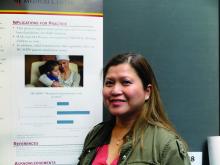ORLANDO – For visits to hematopoietic stem cell transplant recipients, the kids are alright – assuming that they’re not sniffling, coughing, or running a fever, that is.
Since their blood and marrow transplant (BMT) unit began allowing child visits to patients in 2018, there have been no increases in either health care–associated infections or average length of stay, and patient satisfaction has markedly improved, reported Mylene R. de Vera, RN, and colleagues from the Greenbaum Cancer Center at the University of Maryland Medical Center in Baltimore.
Although her center had previously had a policy restricting child visitors out of concerns about transmission of infections, “we did a literature search and found that child visitor restriction is really neither evidence based nor recommended by any professional organization,” she said in an interview at the annual Transplantation & Cellular Therapy Meetings.
“At the same time, I also informally surveyed 10 hospitals and BMT centers nationally, and found that 70% of them allow child visitation,” she added at the meeting held by the American Society for Blood and Marrow Transplantation and the Center for International Blood and Marrow Transplant Research.
An informal survey by this reporter found wide variations in practice. For example, Massachusetts General Hospital Cancer Center policy allows only children 12 and older to visit, but other hospitals have somewhat less stringent policies.
“Our policy is that for children under 12, they need to A) be screened, and B) need to get approval from the attending stem-cell physician,” said Reggie E. Duerst, MD, director of the Stem Cell Transplant Program at Ann & Robert H. Lurie Children’s Hospital of Chicago.
Dr. Duerst, who was not involved in the study, said in an interview seeking objective commentary that his center doesn’t especially encourage visits from younger children, on the understanding that, as every parent knows, the odds are higher that children under 12 may be carrying a respiratory virus, compared with adolescents.
He added that visits from children might be beneficial for patients who are more critically ill or at high risk for dying, but again, only if the child has been carefully screened.
At Memorial Sloan Kettering Cancer Center in New York, children are allowed to visit transplant recipients strictly on a case-by-case basis, and only after consultation with and approval from transplant unit staff, an MSKCC spokesman said.
In an interview, Ms. de Vera cited a 2016 study in the American Journal of Critical Care by Mini Jacob, RN, and colleagues from Emory University in Atlanta, who reported that, among family members visiting patients in an intensive care unit with a continuous visitation policy, open visitation was ranked as the second-most important need.
Beginning in 2018, Ms. de Vera and colleagues sought to promote a patient-centered policy by implementing guidelines that would allow safe visitation by children to BMT recipients.
The process included the aforementioned literature search, survey of other centers, and a staff survey, which showed that 70% of staff said they believed that allowing child visitation would support the goal of patient-centered care. The survey also showed, however, that 40% of staff thought that healthy children presented a higher risk of infection to immunocompromised patients, and 50% agreed with the statement that having children on the unit would be disruptive to care.
In August of 2019, all BMT unit staff members took part in an in-service training session designed “to align perception with evidence-based practice.” The training included detailed information and procedures for screening would-be child visitors for potential risks prior to allowing them on the unit.
The one-page screening tool asks about current or recent infections; coughing, sneezing, etc.; and other health-related issues, including whether the child is up to date on vaccinations.
The following month, the BMT unit implemented its new child visitation policy, and by the end of 2019 the unit had logged a total of 71 child visits.
As noted, there were no increases in either health care–associated infections or in the average length of stay, In fact, from April to September 2019 the average length of stay was 13 days, compared with 18 days during the 6-month period in 2018, before child visits were allowed.
In addition, a Hospital Consumer Assessment of Healthcare Providers and Systems (HCAHPS) patient-satisfaction survey showed that the scores on “taking preferences into account” increased to 92% during October through December 2018, compared with 33% from July through September of the same year.
Interestingly, patient-reported satisfaction also fell by half from January to March 2019, when child visits were suspended as part of hospital-wide restrictions during the influenza season.
A survey of staff conducted a year after the child visitation policy was implemented showed a relative 37% increase in reported awareness that the visits promote patient-centered care, a 35% drop in the reported belief that healthy child visitors pose higher risk of infection, and a more than 100% relative decline in the perception that child visitors would upset BMT unit routine.
“I just wanted to prove to my coworkers that child visitation really did not affect length of stay or health care–associated infections, and at the same time may have a positive effect on patient satisfaction,” Ms. de Vera said.
The study was internally supported. All persons interviewed reported no conflicts of interest to disclose.
SOURCE: de Vera MR et al. TCT 2020, Abstract 588.


